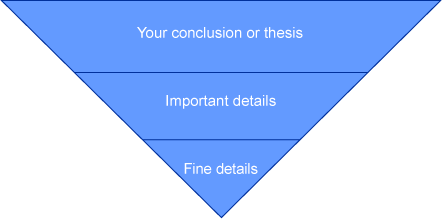

Module 2b —
Report Writing
| Course Guide | Module 1 | Module 2a | Module 2b |
Achieving flow through organization
Report writing has many similarities with newspaper writing. In both cases, the writer needs to get the most important information first, both to tempt readers to go further and to ensure readers have the main point(s) if they decide to abandon the reading.
When your eye runs over the front page of a newspaper, you immediately know what each story is about. If you are interested, you read further to get important details and still further to get fine detail. By reading the first paragraph, you have the expectation that you will know the main drift of the story.
You can visualize this approach by thinking of your writing as an inverted triangle.

As put forward by Barbara Minto in The Minto Pyramid Principle: Logic in Writing, Thinking and Problem Solving, Minto International, 1996
There are many applications of this concept from the whole-document level to the paragraph level.
In a report…
Putting a summary first in a report allows your reader to begin reading with a framework on which to attach new ideas. Comprehension or understanding is only possible when there is a bridge between the new and the known. For example, if you have no experience in piloting an aircraft, it would be difficult for you to understand a lesson on aerobatics. The summary up front gives you some known information on which to link new information.
In a message…
Make sure you have informative subject lines in emails, faxes, and memos.
In a paragraph…
Place your topic sentence at the beginning of a paragraph to help your reader capture the main idea immediately and then fill in the detail.
Flow and your reader
The flow of a piece of writing affects how its readers interpret ideas. If a report's organization fails to provide readers with the information they are looking for in an organized way, they will lose interest.
The reader does not need, or want, to know about all the steps you took along the way to forming your conclusions. The reader wants to know what those conclusions are and if you have sufficient logical support for them. What is required on your part is organization or structuring of your material to express your conclusions clearly and your support for them. Organization is based on:
- providing a hierarchy of ideas for your audience;
- choosing the most appropriate order for those ideas.